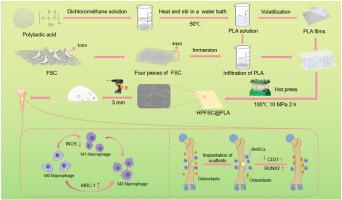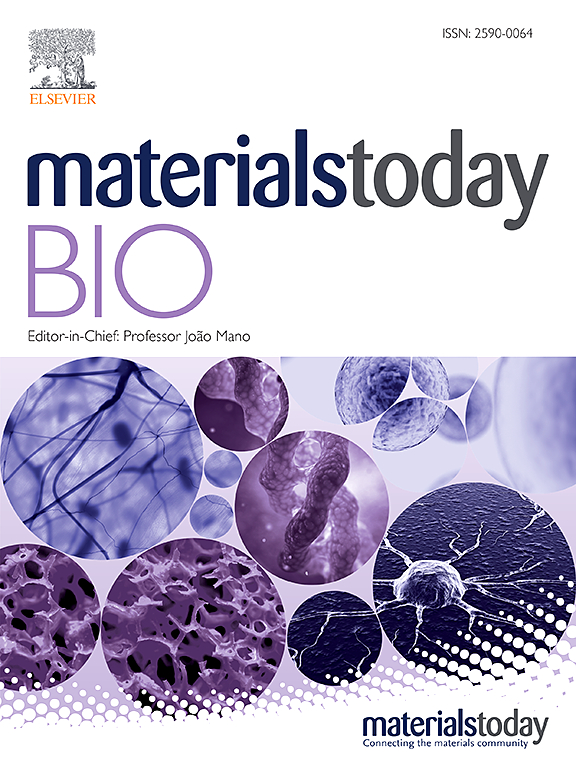具有免疫调节和成骨功能的高性能丝/聚乳酸复合支架材料
IF 8.7
1区 医学
Q1 ENGINEERING, BIOMEDICAL
引用次数: 0
摘要
选择合适的材料和有效的结构设计是影响骨组织工程支架治疗效果的关键。本研究介绍了一种由扁平蚕茧(FSC)和聚乳酸(PLA)组成的可控生物降解复合支架,作为促进复杂损伤骨愈合的创新策略。我们的重点是优化支架的结构设计、机械性能和骨生成的基本机制。最初的实验确定了热压 FSC 的参数,随后进行了机械性能测试,以确定最佳制备条件。随后,利用这些优化参数制作了含有聚乳酸薄膜的复合支架。结果表明,FSC/PLA 复合支架具有出色的生物相容性、机械强度和体外矿化能力,同时降解率也很合适。此外,复合支架在促进成骨分化和促进巨噬细胞向抗炎 M2 表型极化方面表现出了巨大的潜力。在体内将该支架植入有缺陷的区域,可促进成骨,并减轻与降解相关的炎症反应。这项研究提出了一种最佳的复合支架,它能近似模拟骨的复杂结构,为促进骨再生和有效解决实质性骨缺损提供了一种新方法。本文章由计算机程序翻译,如有差异,请以英文原文为准。

High-performance silk/polylactic acid composite scaffold material with immunomodulation and osteogenesis function
The choice of suitable materials and effective structural design are crucial in influencing the therapeutic outcomes of bone tissue engineering scaffolds. This study introduces a controllable biodegradable composite scaffold composed of flat silkworm cocoon (FSC) and polylactic acid (PLA) as an innovative strategy for promoting bone healing in complex injuries. We focused on optimizing the scaffold's structural design, mechanical properties, and underlying mechanisms of osteogenesis. Initial experiments established the parameters for hot pressing the FSC, followed by mechanical performance tests to identify the optimal preparation conditions. Composite scaffolds incorporating PLA films were subsequently fabricated using these optimized parameters. The results indicate that the FSC/PLA composite scaffold exhibits outstanding biocompatibility, mechanical strength, and in vitro mineralization capabilities, alongside an appropriate degradation rate. Furthermore, the composite scaffolds demonstrated significant potential in promoting osteogenic differentiation and facilitating macrophage polarization toward an anti-inflammatory M2 phenotype. In vivo implantation of the scaffold in defective regions enhanced osteogenesis and mitigated inflammatory responses associated with degradation. This investigation presents an optimal composite scaffold that closely mimics the complex structure of bone, offering a novel approach to enhance bone regeneration and effectively address substantial bone defects.
求助全文
通过发布文献求助,成功后即可免费获取论文全文。
去求助
来源期刊

Materials Today Bio
Multiple-
CiteScore
8.30
自引率
4.90%
发文量
303
审稿时长
30 days
期刊介绍:
Materials Today Bio is a multidisciplinary journal that specializes in the intersection between biology and materials science, chemistry, physics, engineering, and medicine. It covers various aspects such as the design and assembly of new structures, their interaction with biological systems, functionalization, bioimaging, therapies, and diagnostics in healthcare. The journal aims to showcase the most significant advancements and discoveries in this field. As part of the Materials Today family, Materials Today Bio provides rigorous peer review, quick decision-making, and high visibility for authors. It is indexed in Scopus, PubMed Central, Emerging Sources, Citation Index (ESCI), and Directory of Open Access Journals (DOAJ).
 求助内容:
求助内容: 应助结果提醒方式:
应助结果提醒方式:


